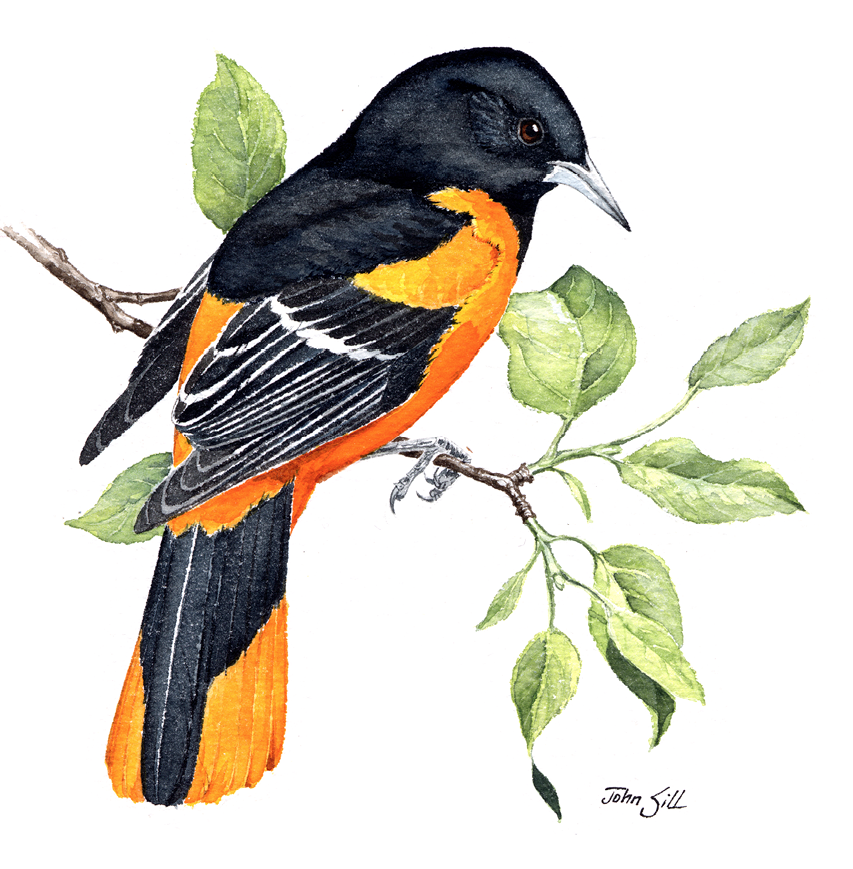Baltimore Oriole by John Sill

Baltimore Oriole by John Sill © Massachusetts Audubon Society. Courtesy of the Museum of American Bird Art.
John Sill is a freelance wildlife artist living in the mountains of North Carolina. He was the illustrator for the Bird Identification Calendar for Mass Audubon for many years. His work has appeared in Birds In Art at the Leigh-Yawkey Woodson Art Museum, Wausau, Wisconsin, and in Art of the Animal Kingdom at the Bennington Center for the Arts in Vermont. He continues to illustrate the "About" and "About Habitats" series of natural history books for children written by his wife Cathryn.
The Baltimore Oriole (Icterus galbula), with its striking plumage and song, has adapted well to suburban life, and is one of our best-known and appreciated songbirds. Males have a black head and back, a black tail edged in orange, and black wings with a white wing bar. The rest of the plumage is bright orange. Females are a smaller, duller, and paler version of males and tend to be brownish rather than black. Highly variable in color, some may be nearly as brightly plumaged as males. As females age, they often look more like males. Immature birds resemble females, and males don't achieve adult plumage until the fall of their second calendar year. The species was originally named "Baltimore bird" in 1731 because orange and black were the colors of the Baltimore family, rulers of the Maryland Colony.
Baltimore Orioles exhibit virtually no geographic variation, and no subspecies have been described. The taxonomic history of the Baltimore Oriole is interesting and complex. A zone of hybridization with the Bullock's Oriole (I. bullockii) in Nebraska and Colorado that was up to 200 miles wide led to the lumping of the two species in 1983 to form the Northern Oriole (I. galbula). Because subsequent studies indicated that the hybrid zone was stable and thus gene flow was restricted, the AOU Check-list Committee in 1995 split the Northern Oriole back into the Baltimore and Bullocks orioles. Recent DNA studies indicate that the two are not even each other's closest relatives.
Baltimore Orioles breed from northeastern British Columbia in a swath across southern Canada to Nova Scotia and south into the United States from the Rocky Mountains to the East Coast as far as Virginia. Inland, they breed farther south to central Louisiana and northeast Texas. They winter in southern Georgia, Florida, Cuba, Jamaica, and the Lesser Antilles. On the West Coast, they winter along the coast of southern California. They also winter from central Mexico throughout Central America to Colombia and Ecuador. In Massachusetts, Baltimore Orioles are a fairly common and widespread breeder and a common spring and fall migrant. They arrive in early May and depart in early August; some immature birds stay until the end of August. They are uncommon to rare in winter, when they occasionally survive the season at feeders.
Baltimore Orioles breed in open deciduous woodlands, forest edges, and in suburban habitats. Males usually sing from a high perch in their territory and their song serves the dual function of territorial advertisement and mate attraction. The male song consists of a series of notes separated by short pauses. The song is loud and has a flute-like quality. Females also occasionally sing but usually have a simpler song than males. Both sexes have chatter calls that are given in aggressive situations. Defending territory may include chases and sometimes attacks using wings, beak, and feet. Generally, males defend territory against both male and female intruders, but females only defend against other females. On the wintering grounds, Baltimore Orioles tend to roost communally, sometimes in the dozens, often with other bird species.
Baltimore Orioles are generally monogamous but extra-pair copulations may occur. They usually produce a single brood. Males arrive a week before females and establish territory. The female selects the nest site. Usually, the female constructs the nest in the outer part of a branch high in a tree, although the male may also bring in nest material. The nest is a hanging, gourd-shaped affair, often suspended from thin branches. It is woven from plant fibers but may include string, plastic, or wood, and is lined with soft plant materials such as milkweed seed plumes or willow cotton, and feathers. Only the female develops a brood patch and she alone incubates the clutch of four to five pale bluish or grayish eggs blotched with a variety of colors for the 12 days until hatching. The male may bring food to the incubating female. She also broods the chicks alone. The chicks are altricial: their eyes are closed, and they are nearly naked when they hatch. Both parents will mob intruders and both feed the young for the 12–13 days until fledging and continue to feed them for an additional two weeks until independence.
Baltimore Orioles are adaptable foragers, mostly gleaning tent caterpillars, other insects, and spiders from trees and shrubs. They also eat fruit and, on the wintering grounds, nectar. They occasionally even hawk flying insects.
Nest predators include grackles, crows, owls, jays, and squirrels. Both parents will attack cowbirds and will destroy cowbird eggs. Although orioles are killed by collisions with human structures, and pesticides have been linked to local population declines, the Baltimore Oriole's adaptability to human environments generally has been advantageous for the species. Breeding Bird Survey data suggest that most populations are stable, so it appears that we will continue to enjoy this lovely species in the future.
William E. Davis, Jr.